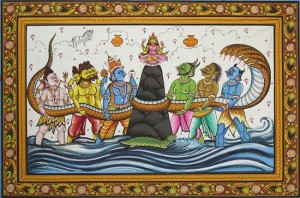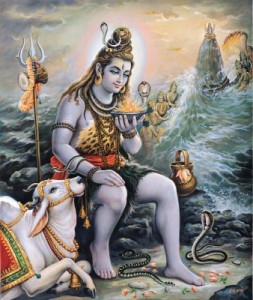 Introduction
Introduction
One of the most compelling stories in Hindu mythology is that of the Churning of the Milky Ocean. It is the story of the gods versus the demons and their fight to gain immortality. It also tells of the rebirth of Lakshmi.
The story is also known as Samudra manthan or Ksheera Sagara Mathanam, and is one of the most famous periods in the Puranas. The story appears in the Bhagavata Purana, the Mahabharata and the Vishnu Purana.
In literal terms, this tale is an allegorical description of what transpires during a kundalini awakening process. Kundalini is a latent energy that lays dormant in the spine. Upon awakening, it rises in a sensation akin to a slithering snake, up the spinal column (represented by Mount Meru in the story).
Vishnu the Saviour
The churning of the Milky Ocean is the story that explains how the gods finally defeated the demons and became immortal.
In the story, Vishnu advised the other gods to churn the Milky Ocean in order to recover a number of lost treasures, including the elixir of immortality and Lakshmi, the goddess of success and wealth. Both of these items would enable the gods to defeat the demons who had taken taken over the universe.
Knowing the gods would be unable to churn the great ocean themselves, Vishnu struck a deal with the demons. He told them they would get a share of the treasures, including the elixir of immortality, if they helped to churn. They agreed.
Vishnu told the gods and demons they should use Mount Madura as a churning stick, and the giant serpent, Vasuki, as a rope.
Vishnu managed to persuade the demons to hold the head of the snake, which was spitting furiously, while the gods held the tail end. The serpent was then coiled around the mountain. Each side alternately pulled the rope then allowed it to relax, causing the mountain to rotate in the water.
Before they could regain the treasures, however, there were many problems they had to face.
As the gods and demons churned, the mountain began to sink into the soft sand bed of the sea.
At the request of the gods, Vishnu incarnated as a turtle. He placed the mountain on his back to act as a foundation stone, thus allowing the churning to continue. Some reports say it was churned for a thousand years before anything came up.
When the elixir of immortality finally rose to the surface, the demons rushed to grab it.
But Vishnu assumed the form of Mohini, a beautiful woman who captivated all the demons. By sleight of hand she changed the elixir for alcohol and returned the precious liquid to the gods.
The churning also brought Lakshmi forth from the ocean. She came as a beautiful woman standing on a lotus flower. Seeing all the gods before her, she chose the god she felt was most worthy of her. Vishnu and she have been inseparable since.
Rebirth of Lakshmi
Indra, the warrior god, was given the responsibility of protecting the world against the demons. He had protected it successfully for many years, and the goddess Lakshmi’s presence had made him sure of success.
One day, a wise sage offered Indra a garland of sacred flowers. In his arrogance, Indra threw the flowers to the floor. According to Hindu belief, this disply of arrogance upset Lakshmi, who left the world of the gods and entered into the Milky Ocean.
Without her, the gods were no longer blessed with success or fortune.
The world became darker, people became greedy, and no offerings were made to the gods. The gods began to lose their power and the asuras (demons) took control.
Indra asked Vishnu what should be done. He told Indra that the gods would need to churn the Milky Ocean to regain Lakshmi and her blessings. He then told them the Ocean held other treasures which would also help them. This included the elixir of life, a potion bestowing immortality, which would enable them to defeat the demons.
The story of the Churning of the Ocean tells of how the gods worked together to churn the ocean. They churned for many years, but it was 1,000 years before anything rose to the surface.
Finally, the treasures began to rise to the surface. Among them, a beautiful woman standing on a lotus flower. This was Lakshmi, who had returned to the world. With her presence, the gods eventually defeated the demons and chased them out of the world.
This story highlights the good fortune and success that Lakshmi bestows upon those who work hard and seek help sincerely. It also demonstrates that during times of success, one must never become complacent or arrogant, as success has a way of getting away from people.
 Blue Throat of Shiva
Blue Throat of Shiva
The Samudra Manthan process released a number of things from the Milk Ocean. One product was the lethal poison known as Halahala. (In some versions of the story, this poison escaped from the mouth of the serpent king as the demons and gods churned.) This terrified the gods and demons because the poison was so powerful that it could contaminate the Milk Ocean and destroy all of creation. On the advice of Lord Vishnu, the gods approached the compassionate Lord Shiva for help and protection. Lord Shiva inhaled the poison in an act to protect the universe that lies inside the Lord Siva, Goddess Parvati pressed her hand in act to save the universe. Some stories suggest that the all powerful goddess pressed his neck to stop the poison from spreading while other stories suggest that Goddess Parvati suckled him in the form of Goddess Tara to stop the poison form spreading. There is another aspect by Dvaitha or dualist philosophies that Lord Vayu collected the poison in a conch and drank the whole except a few drops that spilled from the conch. Lord Shiva took the drops in his skull made bowl and drank in total. It is the power of Parvati’s ear rings that he was saved. As a result, The color of Lord Shiva’s neck turned blue. For this reason, Lord Shiva is also called Neelakanta (the blue-throated one; “neela” = “blue”, “kantha” = “throat” in Sanskrit). When the heat from the poison finally became unbearable for Lord Shiva, he used his trishul to dig for water, thus forming the Gosaikunda lake.